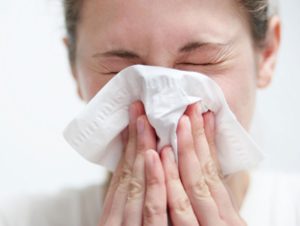What are the 10 most common allergy tablets?
In this article we will describe what are the 10 most common allergy tablets.
In general, there is no cure for allergies, but there are several types of medications available – both over-the-counter (OTC) and prescription – to help ease and treat annoying symptoms like congestion and runny nose.
These allergy drugs include antihistamines, decongestants, combination drugs, corticosteroids, and others.

Sneezing can be a sign of allergy (or cold, flu, COVID-19, or pneumonia!)
Antihistamines
Antihistamines have been used for years to treat allergy symptoms. They can be taken as pills, liquids, nasal sprays, or eye drops. Over-the-counter (OTC) antihistamine eye drops can relieve red itchy eyes, while nasal sprays can be used to treat the symptoms of seasonal or year-round allergies.
1. Cetirizine – others include fexofenadine and loratadine; chlorpheniramine can make you drowsy.
Decongestants
Decongestants relieve congestion and are often prescribed along with antihistamines for allergies. They come in nasal sprays, eye drops, liquids, and pills.
Nasal spray and eye drop decongestants should be used for only a few days at a time because long-term use can make symptoms worse. Pills and liquid decongestants can be taken longer safely.
2. Pseudoephedrine (Sudafed) (or phenylephrine)
Combination allergy drugs
Some allergy drugs contain both an antihistamine and a decongestant to relieve multiple allergy symptoms.
3. Cetirizine and pseudoephedrine (or fexofenadine and pseudoephedrine)
Anticholinergic nasal sprays
These drug can reduce runny nose. When sprayed into each nostril, it lessens mucus from the glands lining the nasal passages.
4. Ipratropium bromide (Atrovent)
Steroids
Steroids, known as corticosteroids, can reduce inflammation associated with allergies. They prevent and treat nasal stuffiness, sneezing, and itchy, runny nose due to seasonal or year-round allergies. They can also decrease inflammation and swelling from other types of allergic reactions.
Steroids are available in various forms: as tablets for serious allergies or asthma, locally acting inhalers for asthma, locally acting nasal sprays for seasonal or year-round allergies, topical creams for skin allergies, or topical eye drops for allergic conjunctivitis.
Steroids are highly effective drugs for allergies, but they must be taken regularly, often daily, to be of benefit – even when you are not feeling allergy symptoms. In addition, it may take 1 to 2 weeks before the full effect of the medicine can be felt. Here are some examples.
Prescription nasal steroid
5. Beclomethasone
Over-the-counter nasal steroids
6. Budesonide (or fluticasone and triamcinolone)
Eye drops
7. Dexamethasone
Oral steroid
8. Prednisolone
Mast cell stabilisers
Mast cell stabilisers treat mild to moderate inflammation. Mast cell stabilisers are available as eye drops for allergic conjunctivitis and nasal sprays for nasal allergy symptoms. Like with many drugs, it may take several weeks before the full effects are felt.
9. Cromolyn sodium
Leukotriene modifiers
Leukotriene modifiers treat asthma and nasal allergy symptoms. They can be prescribed along with other drugs.
These medications are available only with a doctor’s prescription and come as tablets.
10. Montelukast
Other over-the-counter (OTC) products
Some simple over-the-counter products can help with allergy symptoms. They include:
- Saltwater solution, or saline – is available as a nasal spray to relieve mild congestion, loosen mucus, and prevent crusting. These sprays contain no medicine
- Artificial tears – which also contain no medicine, are available to treat itchy, watery, and red eyes.
Summary
We have described what are the 10 most common allergy tablets. We hope you have found it helpful.

